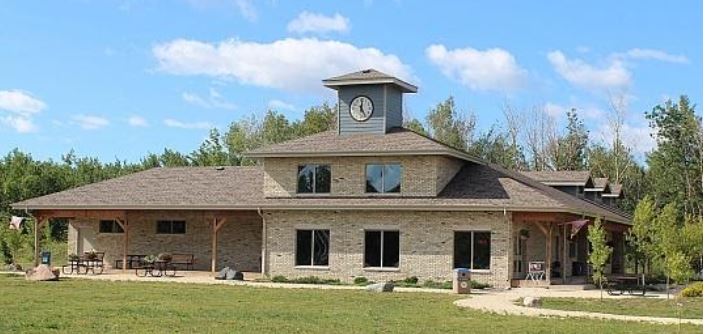On the south east corner of Lake Winnipeg is the village and cottage community of Grand Marais, so named by explorer LaVérendrye in 1736 meaning “the big marsh”. It began as a Métis community, became a busy railroad resort town in the early 1900s, and is now home to many cottagers and a popular provincial park.
During the mid 19th century, Grand Marais existed as a fishery used by the Swampy Cree and the Metis of the Upper and Lower Settlements. Towards the late 19th Century, the fishing community of Grand Marais was permanently settled and formally established as one of Manitoba’s first Metis Communities. These Metis people fished, trapped, and farmed to survive.

The Metis people were the only settlers of this area until in 1914 the Canadian Northern Railway bought 150 acres of homestead land. They planned to use the land to build a campground, and built a rail line that went from Grand Marais to Winnipeg. The CNR set up a resort along the “Grand” Beach, giving Grand Beach its name.
In 1961, the Manitoba Provincial Government bought Grand Beach for $225,000 and established the resort as a Provincial Park. Grand Beach now ranks number three among the top ten North American Beaches, and has many visitors each summer. Grand Beach’s West Beach was given the Blue Flag designation which is an eco-label given for sustainable development. In 1998, weekends in July and August attracted as many as 15,000 visitors per day.
1961 marked the end of the line for the rail service due to the rise in popularity of the automobile. Some believe that the luster associated with the rail era has been lost since the automobile became the dominant means of access to Grand Marais.
Grand Marais Central
Grand Marais geocache site is located in Grand Marais, Manitoba, Canada at GPS coordinates N 50° 32.507 W 096° 37.184. If you find the geocache and scan the QR code inside of it, it brings you here to learn more. Watch all of our videos on our YouTube Channel. Other heritage content can be found on our Red River North Heritage Youtube channel.
Transcription:
In 1736, Pierre La Vérendrye landed on the shores of Lake Winnipeg at the site that he called “the big marsh”, or Grand Marais, as it is known today.
Originally, the community developed as a Metis settlement for fur traders with the Hudson’s Bay Company who spent their winters here trapping and fishing. In later years, fishing and forestry were the major industries.
In 1914, the Canadian National Railway purchased the beach area with intention of building a major resort, and by 1916, the first train rolled into Grand Beach. This train also serviced the East Beaches community of Victoria Beach. The famous Moonlight Express, for a mere fifty cents, hauled thousands of people from Winnipeg to the beautiful, white sand beaches.
At its peak in the 1920s and 30s, the resort featured a large dance pavilion, a carousel, a beautiful boardwalk along the beach, and a two-story hotel.
Interest in Grand Beach waned following the war, with improved roads to other resort areas, particularly in the Whiteshell. In 1950, the dance hall burned down, and the CNR sold the resort area to the province.
Today, Grand Beach is a provincial park, and the beach area is a Blue Flag beach, which is an international standard for a high-quality beach.
The Grand Marais community is being developed for more year-round housing, as seniors retire to the community, and many of the heritage sites are marked for those interested in the heritage of the community.
Much of this history is displayed by interactive exhibits in the East Beaches Heritage Wing, located in the Grand Marais Community Central. This includes a diorama of the train as it was in the 1920s, stories from community elders, and many more fascinating exhibits.